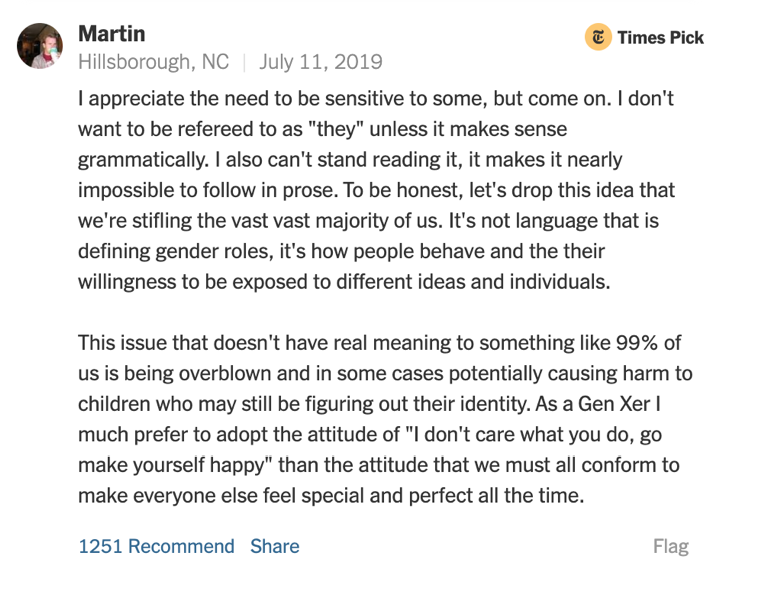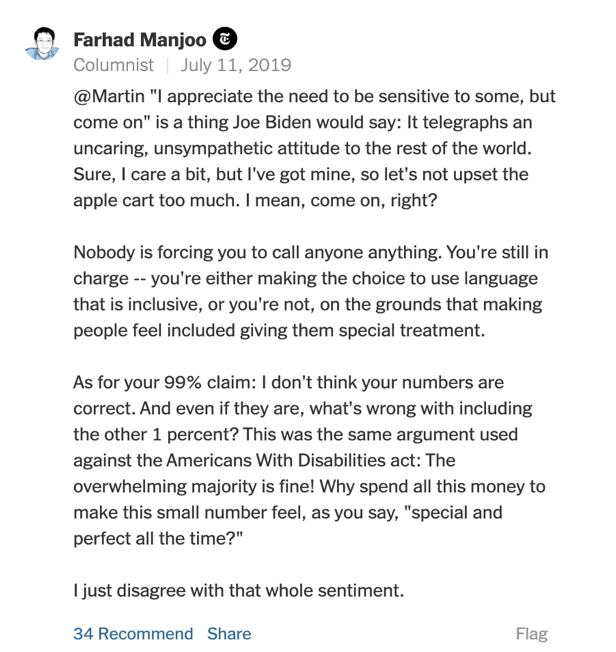Listening
Exercise A: Reading to Understand
Take a look at the following three claims and determine whether or not the author made them. If Manjoo made the claim, answer “true.” If Manjoo didn’t, answer “false.”
On July 10, 2019, The New York Times opinion columnist Farhad Manjoo wrote an article called “It’s Time for ‘They.’” Its main argument? “The singular ‘they’ is inclusive and flexible, and it breaks the stifling prison of gender expectations. Let’s all use it.”
Read the source.
1. According to Manjoo, the world would be slightly better off if we abandoned unnecessary gender signifiers as a matter of routine communication.
2. According to Manjoo, we should use “they” more freely, because language should not default to the gender binary.
3. According to Manjoo, gender is a ubiquitous prison for the mind, reinforced everywhere, by everyone, and only rarely questioned.
Responding
Exercise B: Reading to Respond
Using the same three claims from the previous activity, you’ll again determine whether or not they are “true” or “false.” Only this time, you’ll be answering “true” if you agree with the claim and “false” if you don’t (notice the missing prepositional phrase at the beginning of each sentence!). Hint: There is no right or wrong answer.
1. The world would be slightly better off if we abandoned unnecessary gender signifiers as a matter of routine communication.
2. We should use “they” more freely, because language should not default to the gender binary.
3. Gender is a ubiquitous prison for the mind, reinforced everywhere, by everyone, and only rarely questioned.
Without the prepositional phrase “According to Manjoo,” you take the fairly big step from listening to responding. In doing so, the answers are not as obvious as when you completed the exercise the first time, are they? That’s because you’re not just showing your understanding of the material. Now, you’re in the early stages of responding.
Tip
When determining whether or not an author’s claim is true or false, or whether or not you agree or disagree with it, consider asking yourself some key questions:
- Do the main ideas of the article match my experience or prior learning on this topic?
- Does the author use convincing evidence to support their ideas?
- Do the author’s ideas seem rational or justified?
- Has the author confronted or ignored ideas contradictory to their own?
- Is the article well-structured, i.e. are the ideas within it logically connected?
Comments, or Letters to the Editor
Nowhere is the process of listening and responding better displayed than in the comments section of an online article or letters to the editor in newspapers and magazines. Here, readers like you are given an opportunity to respectfully respond to an author’s argument (once you’ve listened to it, of course).
Take a look at the following conversation between the author, Farhad Manjoo, and one of their readers:


Here, you can see a conversation between reader and writer based on a difference of opinion. Maybe you too have differences of opinion with the author (see Exercise B: Reading to Respond). Or maybe you agree. Either way, determining what you believe in relation to an author’s claims is what it means to respond to a source.
Tip
Typically when you respond to a source, it’s unlikely that the author will be able to answer back, as Farhad Manjoo does in the above example. But that doesn’t mean you can’t anticipate what they would say. In fact, anticipating what an author would say in response to you is an effective method of argumentation. It can also encourage you to make your points as clearly and considerately as possible.
Tip
Before writing, consider including the following structural details in your comment:
An introductory statement or topic sentence that clearly expresses the main point(s) of your comment, i.e. What specific point or points are you trying to get across?
Supporting details so that your main point(s) makes logical sense, not just to you, but to your reader.
A concluding statement, where you try to make a lasting impact on your reader.
Try It!
Try writing your own comment!
In the box below, try writing out your own comment or letter to Farhad Manjoo’s article “It’s Time for ‘They.’” You can draw on relevant skills and strategies covered in Build Your Toolkit.
| TECHNIQUE | SUMMARY |
|---|---|
| Listen | First, actively read the source so that you can “hear” what the author is claiming. |
| Respond | Then, examine the claims themselves so that you can have your own “say.” |
See related subtopics in Absorb and Build Your Toolkit.
Gavin, F., Donville, E., Vavrusa, D., & Buchanan, D. (Eds.) (2010). Effective reading and writing for COMM 170 and beyond. Toronto: Pearson Education.
Letter to the editor. (2020). Teaching the Times. https://sites.google.com/site/teachingthetimes/short-assignments/letter-to-the-editor
Manjoo, F. (2019, July 10). It’s time for ‘they.’ The New York Times. https://www.nytimes.com/2019/07/10/opinion/pronoun-they-gender.html
Answering “true” for each claim shows that you understand—or have listened to—some of the main claims in the article “It’s Time for ‘They’” by Farhad Manjoo. Well done! Listening is the first step when conversing with a source. After all, before responding to someone’s claim, you first have to know what it is, right? Only then can you decide if you agree or disagree, and come up with your reasons why.